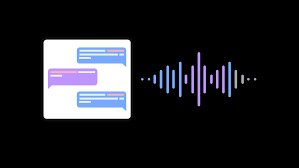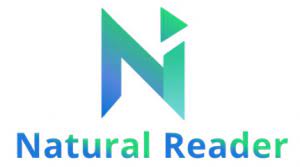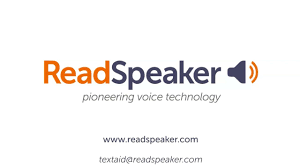Speech synthesis technology has come a long way in recent years, thanks in large part to advancements in artificial intelligence (AI). Today, there are a variety of AI tools available that can generate high-quality synthesized speech, making it easier than ever to create spoken content for a wide range of applications. Whether you're looking to create audiobooks, voiceovers for videos, or even virtual assistants, there's an AI tool out there that can help you achieve your goals.
In this blog, we'll take a closer look at some of the best AI tools for speech synthesis currently available. We'll examine their key features, strengths, and weaknesses, and help you determine which tool is right for your needs. So if you're interested in exploring the exciting world of synthesized speech, read on to discover the top AI tools for speech synthesis in 2023!
Google Cloud Text-to-Speech

Google Cloud Text-to-Speech is a powerful AI tool that enables users to convert text into realistic, natural-sounding speech. With this tool, users can generate audio files that accurately mimic human speech patterns, including inflection, tone, and cadence. The tool uses deep learning techniques to analyze text and generate speech, which makes it possible to produce high-quality audio with minimal post-processing. Moreover, the tool provides a wide range of customization options, including voice selection, pitch, and speed adjustments, which allows users to create unique and personalized audio files.
Pros
Cons
Overall Rank
Amazon Polly

Amazon Polly is a text-to-speech (TTS) service that uses advanced deep learning technologies to synthesize natural-sounding speech from written text. This AI-powered tool allows users to choose from a wide range of lifelike voices in various languages and accents, and customize the tone and style of the voice output to suit their needs. Additionally, Polly offers a real-time streaming feature that enables users to dynamically generate speech as text is being typed, making it ideal for applications that require dynamic speech generation such as voice-enabled chatbots and interactive voice response (IVR) systems. With its intuitive API, easy-to-use console, and robust documentation, Amazon Polly is a powerful tool for developers, businesses, and individuals looking to incorporate high-quality TTS functionality into their applications.
Pros
Cons
Overall Rank
IBM Watson Text to Speech

IBM Watson Text to Speech AI tool is an innovative technology that enables users to convert written text into natural-sounding audio in multiple languages. The AI-powered tool uses advanced neural network models to produce human-like speech, making it an ideal solution for businesses, individuals, and developers who want to enhance the accessibility and user experience of their applications. With Watson Text to Speech, users can customize the pitch, speed, and volume of the audio, as well as choose from a variety of voices to match their brand or personal preferences. Additionally, the tool's built-in pronunciation dictionary ensures that it accurately reproduces complex names and terms, making it a reliable and efficient solution for creating high-quality audio content.
Pros
Cons
Overall Rank
Microsoft Azure Text to Speech

Microsoft Azure Text to Speech is an AI tool that converts written text into natural-sounding speech in multiple languages and voices. The tool uses deep neural networks to synthesize human-like speech with customizable parameters such as speed, intonation, and volume. With Azure Text to Speech, users can improve accessibility for people with visual impairments or provide voice guidance in automated customer service applications. Additionally, the tool offers the ability to personalize the speech with custom voice models to match specific brand personas. This AI tool is easy to use with a simple API integration, enabling developers to add speech capabilities to their applications quickly and efficiently.
Pros
Cons
Overall Rank
NaturalReader

NaturalReader is an AI tool that utilizes text-to-speech technology to read written content out loud. The tool is available as a web application, desktop software, and mobile app, making it highly versatile and accessible. The software is capable of reading a wide variety of text formats including PDF, Microsoft Word documents, and web pages, which makes it useful for students, professionals, and individuals with visual impairments. NaturalReader also provides a variety of customizable features such as adjusting the reading speed, voice type, and pronunciation, allowing for a personalized experience. Overall, NaturalReader is an excellent tool for anyone who needs to read large amounts of text or wants to multitask while listening to written content.
Pros
Cons
Overall Rank
iSpeech

iSpeech is an AI tool that provides high-quality text-to-speech and speech-to-text services for businesses and individuals. With its cutting-edge technology, iSpeech can convert any written text into natural-sounding audio files or transcribe any spoken words into accurate written text. The tool is available in multiple languages and can be easily integrated into various platforms such as mobile apps, websites, and desktop applications. iSpeech is highly customizable, allowing users to select from a wide range of voices, accents, and languages to suit their needs. Whether it's for accessibility purposes, language learning, or content creation, iSpeech is an excellent tool for anyone looking for reliable and efficient speech recognition and synthesis services.
Pros
Cons
Overall Rank
Acapela Group

Acapela Group is a cutting-edge AI tool that specializes in text-to-speech conversion. The platform utilizes advanced algorithms to transform written text into natural-sounding speech that closely mimics human intonation and expression. With Acapela Group, users can generate voice recordings for a wide range of applications, including virtual assistants, audiobooks, and e-learning courses. One of the most impressive features of Acapela Group is its ability to customize the voice of the generated speech. Users can select from a diverse range of natural-sounding voices and even create their own voice models to match the tone and style of their brand. Overall, Acapela Group is an excellent tool for businesses looking to improve the accessibility and user experience of their digital content.
Pros
Cons
Overall Rank
ReadSpeaker

ReadSpeaker is an innovative AI tool that converts written text into high-quality speech in a natural-sounding voice. It offers a wide range of features such as multi-language support, customizable voice and speed, and integration with various platforms such as websites, e-learning platforms, and mobile apps. ReadSpeaker not only enhances the accessibility of digital content for people with visual impairments, dyslexia, and other disabilities, but also improves the overall user experience by providing an option to listen to the content on the go. The tool is also useful for language learning, as it allows learners to listen to text in different languages and improve their pronunciation and comprehension skills.
Pros
Cons
Overall Rank
CereProc

CereProc is an AI tool that is used for text-to-speech (TTS) conversion. What sets CereProc apart from other TTS tools is its ability to create unique, lifelike voices that are based on real individuals. This is achieved through a process called voice cloning, where CereProc records and analyzes the voice of an individual, and then creates a digital voice model that can be used to generate speech. The resulting voices are highly realistic, with unique inflections, tones, and accents that capture the nuances of the original speaker's voice. This makes CereProc an ideal tool for creating personalized voice assistants, audiobooks, and other applications where a natural, human-like voice is required.
Pros
Cons
Overall Rank
Tacotron 2

Tacotron 2 is a state-of-the-art AI tool that uses deep learning techniques to generate highly natural-sounding speech from text. Developed by Google, Tacotron 2 is a neural network-based text-to-speech (TTS) system that leverages a combination of sequence-to-sequence models, attention mechanisms, and waveform synthesis to create realistic and expressive speech. What sets Tacotron 2 apart from traditional TTS systems is its ability to capture the nuances and subtleties of human speech, such as intonation, rhythm, and stress. This makes it a powerful tool for a wide range of applications, from virtual assistants and automated call centers to audiobooks and language learning platforms.
Pros
Cons
Overall Rank
Deep Voice 3

Deep Voice 3 is an artificial intelligence (AI) tool that uses deep learning to generate natural-sounding human speech. It employs a neural network architecture that is trained on large amounts of speech data to produce high-quality speech synthesis. The tool has been widely adopted in the industry for various applications, such as voice assistants, text-to-speech systems, and voice dubbing. With its advanced algorithms, Deep Voice 3 can generate speech in different languages and accents, making it a versatile tool for global businesses and industries. Moreover, it allows for customization of the generated voice, allowing developers to create unique and distinctive voices for their applications.
Pros
Cons
Overall Rank
WaveNet

WaveNet is an AI tool developed by DeepMind, a subsidiary of Google. It is a deep neural network designed to synthesize natural-sounding speech. The uniqueness of WaveNet lies in its ability to generate waveforms from scratch, allowing it to create highly realistic and natural-sounding audio. The system works by modeling the raw audio waveform directly, making it possible to generate sound at a much higher quality than traditional text-to-speech systems. WaveNet has a wide range of applications, including voice assistants, audiobooks, and even in the creation of music.
Pros
Cons
Overall Rank
Lyrebird

Lyrebird AI is a powerful voice synthesis tool that can create highly realistic and natural-sounding human voices. The tool is designed to mimic the unique vocal characteristics of an individual, allowing users to generate a voice that sounds just like them. This has a wide range of applications, from creating realistic voiceovers for films and animations, to providing personalized text-to-speech services for individuals with speech impairments. Lyrebird AI uses deep learning algorithms to analyze speech patterns and produce high-quality voice samples, making it one of the most advanced voice synthesis tools available today.
Pros
Cons
Overall Rank
VoiceForge

VoiceForge is an AI-powered text-to-speech (TTS) tool that allows users to convert written text into spoken words with natural-sounding voices. It offers a range of voices to choose from, including male and female voices with different accents and tones, which can be customized to match specific needs. The tool is user-friendly and can be integrated with various applications, such as video editors and e-learning platforms, to create engaging and interactive content. Additionally, VoiceForge provides a cloud-based service, making it easy to access the tool from anywhere and at any time.
Pros
Cons
Overall Rank
TTSReader

TTSReader is an AI-powered tool that can convert any text into speech, allowing users to listen to written content instead of reading it. The tool uses natural language processing (NLP) and text-to-speech (TTS) technologies to provide a high-quality audio output that sounds like a human voice. TTSReader also offers a variety of customization options, such as the ability to adjust the speed and pitch of the voice and choose from multiple languages and accents. This makes it a useful tool for people with visual impairments or those who prefer listening to reading.
Pros
Cons
Overall Rank
SpeechKit

SpeechKit is an advanced AI tool that converts text to speech with exceptional accuracy. It utilizes state-of-the-art deep learning algorithms to produce natural-sounding human speech that can be used in a variety of applications, including audiobooks, podcasts, voice assistants, and more. One of the notable features of SpeechKit is its ability to personalize the generated voice to match the target audience's age, gender, and accent, making it a highly customizable solution for businesses seeking to enhance their user experience. With SpeechKit's easy-to-use API, developers can integrate its speech synthesis capabilities into their apps and services seamlessly, enhancing their accessibility and engagement.
Pros
Cons
Overall Rank
In conclusion, the field of AI has seen incredible advancements in speech synthesis technology in recent years, and there are now several outstanding tools available to users. From the easy-to-use and free Google Text-to-Speech, to the powerful and customizable DeepScribe, there is no shortage of options for those seeking to generate high-quality synthesized speech. One thing to keep in mind when choosing an AI tool for speech synthesis is the specific use case for which it will be employed. For example, some tools may be better suited for creating audiobooks or podcasts, while others may be ideal for generating high-quality voiceovers for videos or advertisements. Additionally, factors such as cost, ease of use, and customization options may also play a role in the decision-making process. Overall, the best AI tools for speech synthesis are those that provide users with a combination of accuracy, flexibility, and ease of use. With continued advancements in AI technology, we can expect even more innovative tools and features to emerge in the future, further expanding the possibilities of synthesized speech in various industries and applications.
